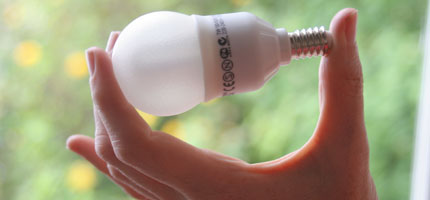
A bulb a day keeps climate change at bay (or something along those lines...)
We've had a lot of support for our current light bulbs campaign (and some detractors too, it has to be said) but there have been many queries about whether compact fluorescent lamps (CFLs) really are what they're cracked up to be - what about the mercury, can they be recycled, that sort of thing. Many of them have already been covered elsewhere on the site, but it's worth following them up in a slightly more prominent position.
If you have any more queries, just post a comment below or contact us at info@uk.greenpeace.org.
Are CFLs more polluting than incandescent bulbs because they contain mercury?
They do contain a small amount of mercury, but that doesn't make them worse for the environment. For a start CFLs can be recycled, as we'll see, but on top of that most people don't realise that incandescent bulbs are also responsible for the release of mercury. When fossil fuels (especially coal) are burnt to provide electricity, mercury is released - it's one of the biggest sources in the environment. Because they use much more electricity over the lifetime of the bulb, incandescents lead to the release of more mercury than is contained in a CFL.
Hang on, CFLs can be recycled?
Absolutely, so the mercury can be safely recovered and used again. The Waste Electric and Electrical Equipment (WEEE) directive, recently introduced by the EU, compels retailers and manufacturers to safely recycle and dispose of old electrical products, and this includes CFLs. However, as far as I know, only Ikea currently offer a take-back policy (and anecdotal evidence is they'll take any bulbs, not just their own brand). We wait with baited breath for the rest to follow suit. In the meantime, if you have some expired CFLs lying around, you could try taking them to your nearest retailer, quote an obscure piece of EU legislation to the manager and see what happens! There is also the old fashioned method of going to the recycling bank - find the site closest to you on Recycle More (bulbs are under 'General WEEE').
But what about recycling incandescent bulbs?
Sadly, they're not covered by WEEE. It's landfill for them. It's in no way ideal, but there are currently no means to recycle them.
In that case, I'm going to wait until they blow before replacing them with CFLs.
Ah, now here's where it gets a bit tricky. Incandescent bulbs are going to end up in landfill anyway, so the question is: do you put them in the bin now or later? If you continue to use them until they break, they'll still be using 80 per cent more electricity compared to CFLs. If you throw them away now, the energy and materials used in their production will be wasted but that will eventually be outweighed by the amount of energy saved from using CFLs. On balance, the best thing you can do is to change your light bulbs now - the energy saved is more significant than keeping those incandescents out of landfill for a few more months.
I can't use fluorescent lighting for medical reasons. If incandescent bulbs are banned, I'll be living in the dark.
We don't expect incandescent bulbs to be banned outright and people who suffer from ultraviolet or general light sensitivity could have access to them through a prescription from their doctor. But there's no reason why high street shops need to keep selling them.

